 |
| Contents |
| |
| 10 Continuing Professional Development
|
| |
| This is one of the chapters of the Basic Education Curriculum Guide - To Sustain, Deepen and Focus on Learning to Learn (Primary 1 - 6). Its contents are as follows: |
| 10.1 |
Background |
| 10.2 |
Purposes of the Chapter |
| 10.3 |
Review and Reflection |
| 10.4 |
Teacher Professional Development and School-based Curriculum Development |
| 10.5 |
Planning and Implementation |
| 10.6 |
Building Communities of Practice at School |
| Remarks |
| References |
|
| |
| |
| 10.1 Background |
| |
| There is an inseparable relationship between student learning outcomes and teaching effectiveness of teachers1. As the curriculum reform proceeds, the expectation of schools on teachers has gradually evolved from teachers’ individual capability into the collaboration within a subject panel. Teachers are expected to implement the school-based curriculum and adopt a whole-school approach in learning and teaching with a view to enhancing student learning effectiveness and catering for learner diversity. |
| At present, the role of teachers is not limited to teaching. They are facilitators for helping students learn to learn for whole-person development. Development of a learning culture and a knowledge management system is now advocated in both public and private sectors to enhance corporate effectiveness. Resources are also invested in providing training opportunities for their employees. In this connection, adjustments should be made to teachers’ professional development to meet the new challenges in the future. |
| |
| |
| 10.2 Purposes of the Chapter |
| |
 |
Provide an overview of the professional development of teachers in the past decade |
 |
Review different opportunities for professional development of teachers |
 |
Illustrate how professional development of teachers can effectively facilitate the attainment of student learning outcomes |
|
| |
| |
| 10.3 Review and Reflection |
| |
| Education is a profession, and by definition, “a profession is the work of persons who possess a body of knowledge, skills, and practices that their professionalism must be continually tested and upgraded with colleagues”2。. For this reason, life-long learning is just as pertinent to teachers as it is to students. |
| There are various dimensions to the continuing professional development (CPD) for teachers, including support for new education policies, implementation of new tasks in school and response to major concerns of the school as well as personal professional growth3. Professional development for teachers involves the personal, school and community levels, with the prime goal of enhancing student learning outcomes. (See Figure 10.1) |
| |
| Figure 10.1: Teacher Professional Development on Different Levels |
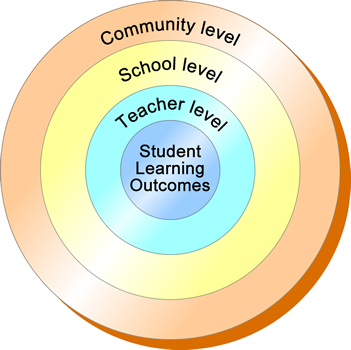 |
| |
| There have been a number of changes in teacher professional development in the last decade. The Advisory Committee on Teacher Education and Qualifications (renamed as the Committee on Professional Development of Teachers and Principals (COTAP) since 1st June 2013)4 devised the “Teacher Competencies Framework” in 2003, which proposes the four domains of “Teaching and Learning”, “Student Development”, “School Development” and “Professional Relationships and Services” for schools and teachers to plan and evaluate the direction and content of teacher professional development. Aiming to improve teachers’ professional standards by encouraging teachers to participate in structured or other modes of CPD activities in different domains, the Committee has also devised a “soft indicator” involving 150 hours of CPD activities within a 3-year span. In the 2003/04 school year, the Chief Executive’s Awards for Teaching Excellence was launched to acknowledge outstanding teaching performance, with an emphasis on the pursuit of excellence and culture of collaboration. Nowadays, schools are improving teaching quality and effectiveness through a range of diversified professional development activities, as mentioned in the Inspection Annual Reports over the years. These activities include the introduction of external professional support and/or making use of collaborative lesson planning and peer observation to encourage professional interaction and exchanges among teachers. |
|
| |
| To consolidate the experiences of professional development programmes held by different schools, some good practices and areas for reflection are observed and briefly reported as follows: |
| Recommended Measures |
 |
Encourage teachers’ participation and reach a consensus among them when mapping out teacher professional development activities and policies. |
 |
Devise the school-based CPD policies according to its developmental needs. |
 |
Implement teacher professional development as a long-term human resource strategy. |
 |
Facilitate school-based curriculum development through teacher professional development activities. |
 |
Align the major concerns of the school with all teacher professional development activities, e.g. teaching Chinese to non-Chinese speaking students as a second language, and conduct evaluation as appropriate. |
 |
Establish a mechanism for experience sharing in the school for teachers who have completed external professional development activities |
 |
Designate specific slots in the timetable for collaborative lesson planning for teachers teaching the same subject and level for discussion of teaching strategies and teaching difficulties. |
 |
Exploit information technology such as the intranet to upload teaching notes and PowerPoint slides to promote the sharing of knowledge. |
 |
Create a collaborative learning atmosphere and encourage teachers’ self-evaluation, peer evaluation, etc. to foster professional growth. |
 |
Refer to the Professional Development for Beginning Teachers – An Induction Tool Kit published by the COTAP for setting up or improving school-based induction programmes to help new teachers integrate into the school. |
| |
|
|
 |
Combine collaborative lesson planning and peer lesson observation; establish clear foci in observation; strengthen post-observation evaluation and discussion to enhance teaching effectiveness. |
 |
Devise teacher capacity enhancement plans for teachers alongside the introduction of external professional support for the sake of sustainable development. |
 |
Organise joint events with other schools to enable teachers to make reference to their success experience in the learning and teaching and gain insights. |
|
| |
| Areas for Reflection |
 |
Are the goals and directions of the teacher professional development activities clear enough? |
 |
Have the need and priority been thoroughly evaluated before coming to the decision of joining any external collaboration and development projects? |
 |
Will the effectiveness be monitored when these teacher professional development activities take place? |
 |
Is there any coordination between subjects to prevent the overlapping of teacher professional development activities? |
 |
Are the teacher professional development activities closely connected to students’ learning or other areas? |
 |
How can schools avoid making the teacher professional development activities a routine, failing to address the major concerns of the school? |
 |
Is consensus reached among teachers before any external professional support is introduced? |
 |
How could the positive impact and experience be sustained and deepened after the end of external professional support services? |
 |
How could schools make good use of “The Teacher Competencies Framework” to understand the professional competency of all staff members in different domains, and devise a holistic teacher professional development plan accordingly? |
|
| |
 Exemplar: The Joint-school Teacher Professional Development Day Exemplar: The Joint-school Teacher Professional Development Day |
| School A and School B jointly hold a teacher professional development day, which lasts for a whole day |
| Before the event |
 |
Questionnaires are delivered to all teaching staff of both schools to understand what issues they are concerned about or would like to understand further. |
 |
After a statistical analysis and discussion, it is determined that “students’ learning styles” is to be the theme of the professional development day. A section of “team building” is also added to facilitate collaboration among teachers. |
 |
Before the event, the committees of teacher professional development of both schools have a conference to discuss the expected outcomes, content, guest speakers to be invited, the programme of the event, venues, extended activities, etc. |
| On the day of the event |
 |
Both schools give a brief introduction to the teacher professional development in recent years and their major concerns, followed by icebreaking games that create a shared experience to help the teachers from both schools understand one another and develop team spirit. |
 |
Guest speakers specialising in child psychology introduce the different learning styles of students, their characteristics and areas of concern to the teachers. |
 |
Subsequently, teachers of both schools are engaged in “cooperative learning” and divided into expert groups focusing on a particular learning style, namely visual, auditory and kinesthetic. Each group lists students’ specific learning needs and major concerns based on the respective learning style. |
 |
After discussion, each member of the expert groups returns to their respective subject panel that consists of members from both schools to devise customised learning and teaching strategies according to students’ learning styles, curriculum goals and the characteristics of the subject concerned. Their ideas are presented by a selected group leader. |
 |
After lunch, a team building activity led by adventure specialists is held at School A to enhance teachers’ team spirit and a collaborative atmosphere through a series of team activities and competitions. |
 |
The activity is concluded by the principals of both schools, followed by the collection of post-activity questionnaires completed by the teachers, for the purpose of analysis and evaluation. |
| After the event |
 |
The teachers of Schools A and B remain in touch and share their experience of teaching students with different learning styles as well as exchanging teaching notes, PowerPoint slides, etc. |
|
|
| |
 For Reflection and Action For Reflection and Action |
 |
How should teachers equip themselves? |
 |
How can the school management facilitate teacher professional development? |
 |
How do the current professional development activities bring positive impacts on student learning? |
|
|
| |
| |
| 10.4 Teacher Professional Development and School-based Curriculum Development |
| |
| Schools should plan a school-based curriculum with unique features according to their developmental needs, for instance: |
 |
Using subjects as the development core, e.g. language subjects, General Studies |
 |
Orientating themes as the development objectives, e.g. the Four Key Tasks, generic skills |
 |
Making reference to the school development plan and major concerns, e.g. catering for learner diversity, small class teaching |
| |
| Teacher professional development functions as the momentum for school-based curriculum development as the latter requires both the school and teachers to “take on the major responsibility for deciding on the curriculum content and learning resources as well as the implementation of the ‘teaching-learning-assessment cycle’”5。. Teacher professional development activities can be very diversified, ranging from structured learning to other learning modes, which cover the personal, school and community levels (See table 10.1). On the personal level, in order to facilitate personal growth, enhance pedagogical knowledge of subject and prepare for establishing a team with “distributed leadership” in the school, teachers may plan according to their experience, specific requirements and personal learning needs. |
| |
| Table 10.1:Examples of Teacher Professional Development Modes |
|
Teacher |
School |
Community |
| Personal Growth |
Pedagogical Knowledge of
Subject |
Whole-school |
KLA/
Subject |
EDB |
Others* |
| Structured Learning |
Courses, conferences, seminars, talks & workshops |
Teacher Development Day |
Subject panel meetings (e.g. collaborative curriculum design) |
Training Calendar: courses, seminars & talks |
Courses, conferences, seminars & talks |
| Online courses |
Retreat |
| Higher education courses, and courses relevant to their teaching qualifications |
Joint school events |
| Other Learning Modes |
Networks and social media |
Become members of subject- related organisations (SROs) |
Programme, pioneering projects, e.g. Quality Education Fund (QEF) |
(“Seed”) projects |
School visits |
| Teacher induction schemes or mentorship programmes |
Serve as guest speakers for other schools |
Outbound or overseas educational visits |
Collaborative lesson planning |
School-based Professional Support Services |
School or district networks |
| Reading |
Read professional articles, journals, etc. |
School visits and exchange visits |
Peer lesson observation |
Secondment, Scheme of Voluntary postings to schools, Cross-grade Posting Scheme |
School-based support |
| Publish essays, reports, books, etc. |
Professional Discourse |
Learning groups |
Collaborative analysis of students’ work and data |
Curriculum development visits |
University-School Support Programmes (USP) |
| Reflective journals |
Peer Learning |
|
Action learning and research |
Collegial Participation in External School Review |
Business- school Partnership Programme(BSPP) |
| Sabbatical leave |
|
|
Learning circles,
Communities of Practice |
Mainland-Hong Kong Teachers Exchange and Collaboration Programmes |
|
| Serve the education sector or communities (e.g. as a guest speaker, a member of a working group) |
|
Individual guidance |
|
|
|
| * Includes school sponsoring bodies or universities, NGOs, other schools, other parties, etc. |
|
| |
| Besides, in response to the teacher professional development frameworks provided by the EDB in different domains, schools should devise a distinct school-based training programme to facilitate the implementation of the school-based curriculum and meet the different learning needs of students. The teacher professional development frameworks include: |
 |
Teacher Professional Development Framework on Integrated Education: To enhance the professional capacity of teachers in catering for students with special educational needs (SEN), the EDB offers structured Basic, Advanced and Thematic (BAT) Courses for serving teachers. |
| |
|
|
 |
Professional Development Framework in Gifted Education: In order to meet the needs of school stakeholders, the EDB provides appropriate training in gifted education for teachers to facilitate the sustainable development of gifted education in schools. |
| |
|
|
| |
| In order to encourage and facilitate school-based curriculum development, the EDB has provided various support services to schools and teachers over the last decade, including: |
 |
Primary Education - Collaborative Research and Development (‘Seed’) projects |
 |
School-based Curriculum Development in the Primary Schools |
 |
School-based Professional Support |
| |
|
|
| |
 Exemplar: Collaborative Research and Development ("SEED") Project - General Studies Exemplar: Collaborative Research and Development ("SEED") Project - General Studies |
| Objectives: To help students develop critical thinking skills and creativity through enquiry-based learning in General Studies. |
| This project consists of two components, namely development and research. The development component involves developing learning resources as well as teaching strategies for nurturing students’ critical thinking skills and creativity. The research component is to investigate the factors affecting the implementation of the curriculum of General Studies in order to enhance the learning and teaching strategies as well as to improve the curriculum development. |
| To achieve the two project objectives of developing students’ critical thinking skills and creativity, the seconded teachers and the SEED schools develop resources, plan and try out different learning and teaching strategies collaboratively. Drawing on the successful experiences, they compile the useful teaching resources and develop an exemplar for other schools’ use and reference. |
Exemplars developed from the above project include:
- Young Fashion Designers
- Adventure in the Sun's Kingdom |
| To sum up, not only has this project set an example for other schools, but it has also brought about a new work experience to the seconded teachers. Through discussion, collaboration and interaction with teachers from partner schools, the project has offered the teachers an opportunity for individual professional development and personal growth while bringing benefits to the schools they work for. |
|
|
| |
 For Reflection and Action For Reflection and Action |
 |
What is the current arrangement of professional development activities at your school? Does it fulfil your needs? |
 |
In what areas do you see room for improvement? What kind of professional development activities will benefit you most? |
|
|
| |
| |
| 10.5 Planning and Implementation |
| |
| As the Basic Education Curriculum Guide (Primary 1 - 6) maps out the direction for primary curriculum development in the coming decade, planning of an effective teacher professional development programme is pivotal as it ensures a more sustainable, deepened and focused development of school-based curriculum. The figure below is part of the teaching professional development planning tools. School may refer to it according to their needs: |
| |
| Figure 10.2:Planning ─ Implementation ─ Evaluation |
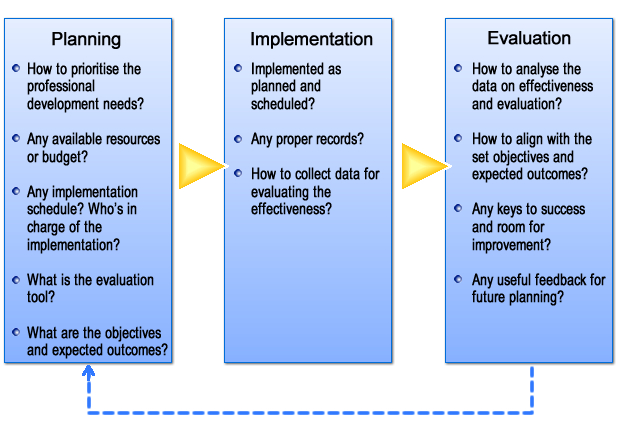 |
| |
| Table 10.2:Needs Analysis on Professional Development |
| Level of Demand |
Items
(Examples*) |
|
Importance
(High, medium, low) |
Urgency
(High, medium, low) |
Level of Needs
(Personal, subject panel, whole-school) |
Priority
(1, 2, 3…) |
| Small Class Teaching |
|
|
|
|
E-Learning
|
|
|
|
|
| Catering for Learner Diversity |
|
|
|
|
Four Key Tasks
|
|
|
|
|
Generic skills
|
|
|
|
|
|
| * The above examples only cover the “Teaching and Learning” Domain of the Teacher Competencies Framework |
| |
| Figure 10.3:The Importance-Urgency Matrix |
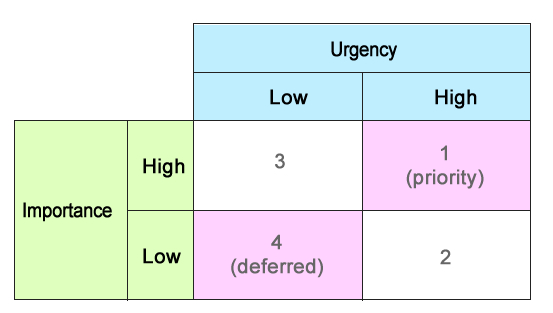 |
| Note: |
The priority (1, 2, 3, 4) of professional development programmes should be determined depending on their importance and urgency. |
|
| |
|
| Figure 10.4:The Keep, Improve, Start, Stop (KISS) Analysis |
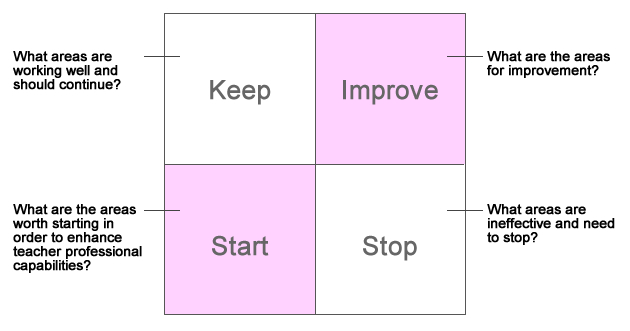 |
| |
| Additionally, schools may make reference to the “Professional Development for Beginning Teachers – An Induction Tool Kit” to devise an “Induction Completion Reference” (ICR) comprising a set of school-based pointers to optimise the school-based induction programmes and provide beginning teachers with appropriate induction and support. Table 10.3 provides an excerpt from the “Teaching and Learning” domain. Apart from the domain of “Teaching and Learning”, schools may also devote attention to other domains including “Student Development”, “School Development” and “Professional Relationships and Services” to provide new teachers with comprehensive learning experiences. |
|
| |
Table 10.3: “Induction Completion Reference (ICR)”– Interim and Final Reviews
(An excerpt from the “Teaching and Learning” Domain) |
|
| Note: |
Schools can adopt or adapt the “Professional Development for Beginning Teachers – An Induction Tool Kit” to meet their school-based needs. For example, school-based indicators could be inserted to the “descriptor” column. Apart from pointing out the areas for improvement, strengths can also be listed. |
|
| |
| |
| 10.6 Building Communities of Practice at School |
| |
| Communities of Practice (CoP) are groups of people who share a concern or a passion for something they do and learn how to do it better as they interact regularly6. There are three basic elements in the model of CoP – the Domain, Community and Practice. In the school context, the combination of these three elements constitutes a “community of practice at school”, which aims to facilitate the attainment of student learning outcomes (See Figure 10.5). |
| |
| Figure 10.5:Communities of Practice at school |
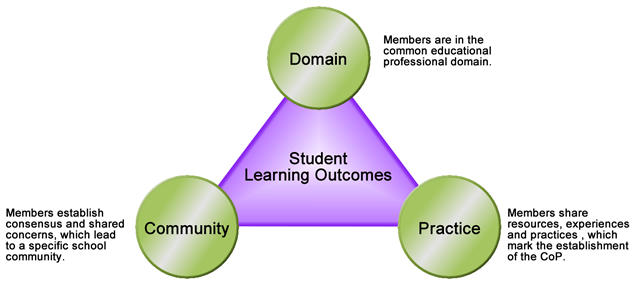 |
| |
| Schools are recommended to adopt the measures below to establish CoP at school: |
 |
Share the responsibility of professional development between teachers and the management to nurture CoP at school (see Table 10.4). |
 |
Cultivate a learning culture among teachers and the management to create a shared vision. |
 |
Establish teams of “distributed leadership” and breed leaders in each domain. |
 |
Starting from a point, line or plane, encourage different modes of CoP according to needs. |
 |
Create room for teachers to cultivate the culture of equality, sharing and collaboration. |
 |
Provide opportunities or create room for teachers to share their knowledge gained from professional development programmes and to conduct tryouts or action research in the key learning area or the subject panel concerned. |
 |
Make student learning outcomes the common concern of CoP. |
 |
Create multiple CoP at school according to needs. |
|
| |
| Table 10.4:The responsibilities of different school staff members in contributing to the establishment of CoP at school |
| School staff |
| Responsibility |
|
Teacher |
KLA/
Subject Coordinator |
Primary School Curriculum Leader |
School Head/
Deputy Head |
| Role |
Member |
Facilitator |
Change agent |
Supporter |
| Mission |
Share responsibilities |
Facilitate collaboration and development among KLAs/subjects |
Coordinate or catalyse interactions |
Empower |
| Objectives Setting |
Actively participate or contribute |
Define the scope, prioritise and set expected outcomes |
Coordinate subject panel tasks |
Define objectives and areas of concern |
| Resources |
Make optimal use of resources or share them |
Devise programme budgeting plans and source relevant resources |
Allocate resources |
Approve budget, seek new resources |
| Collaboration |
Co-construct pedagogical knowledge of the subject |
Facilitate coordination at the subject panel level |
Provide appropriate frameworks (e.g. collaborative lesson planning sessions) |
Create capacity for collaboration (including resources, staffing, time) |
| Evaluation |
Feedback |
Analyse |
Monitor |
Evaluate |
|
| |
 For Reflection and Action For Reflection and Action |
 |
Do you agree with the rationale of establishing CoP at school? Why? |
 |
Do you believe your school has the conditions for establishing CoP? If yes, how would you describe the results? If not, what is missing? |
|
|
| |
| |
| Remarks |
| |
| 1 |
Mourshed, M., Chijioke, C., and Barber, M. (2010). How the World's Most Improved School Systems Keep Getting Better. London: McKinsey & Co. Retrieved from
http://mckinseyonsociety.com/how-the-worlds-most-improved-school-systems-keep-getting-better/ |
| 2 |
Glickman, C.D. (2002). Leadership for Learning: How to Help Teachers Succeed. Alexandria, VA: Association for Supervision and Curriculum Development (ASCD). |
| 3 |
OECD (2005). Teachers Matter: Attracting, Developing and Retaining Effective Teachers. France: OECD. |
| 4 |
The Advisory Committee on Teacher Education and Qualifications (ACTEQ) has been renamed as the Committee on Professional Development of Teachers and Principals (COTAP) since 1st June 2013. |
| 5 |
Curriculum Development Institute (CDI) & The Open University of Hong Kong (OUHK). (2002). Curriculum Change: Leadership and Management (Module II: Teachers as Participants in Curriculum Development) (In Chinese). Hong Kong: Authors. |
| 6 |
Wenger, E. (1998). Communities of Practice: Learning, Meaning, and Identity. Cambridge, UK: Cambridge University Press. |
|
| |
| |
| References |
| The following references are by no means exhaustive and listed below for reference only. |
| Publications |
| Advisory Committee on Teacher Education and Qualifications (ACTEQ). (2003). Towards a Learning Profession: The Teacher Competencies Framework and the Continuing Professional Development of Teachers. Hong Kong: ACTEQ. |
| |
| Darling-Hammond, L., & Richardson, N. (2009). Teacher learning: What matters? Educational Leadership, 66(5), 46-52. |
| |
| Darling-Hammond, L., & Rothman, R. (Eds.). (2011). Teacher and Leader Effectiveness in High-performing Education Systems. Washington, DC: Alliance for Education & CA: Stanford Center for Opportunity Policy in Education. |
| |
| Education Bureau (2011). School Administration Guide. Hong Kong: Education Bureau. |
| |
| Glickman, C.D. (2002). Leadership for Learning: How to Help Teachers Succeed. Alexandria, VA: Association for Supervision and Curriculum Development. |
| |
| Ko, E., & Leung, W. K. (2008). Training – Starting from Zero (In Chinese). Hong Kong: City University of Hong Kong Press. |
| |
Mourshed, M., Chijioke, C., & Barber, M. (2010). How the World’s Most Improved School Systems Keep Getting Better. London: McKinsey & Co. Retrieved from
http://mckinseyonsociety.com/how-the-worlds-most-improved-school-systems-keep-getting-better/ |
| |
| OECD (2005). Teachers Matter: Attracting, Developing and Retaining Effective Teachers. Paris: OECD Publishing. |
| |
| Schleicher, A. (Ed.) (2012). Preparing Teachers and Developing School Leaders for the 21st Century: Lessons from Around the World. Paris: OECD Publishing. |
| |
| Schwille, J., & Dembele. M. (2007). Global Perspectives on Teacher Learning: Improving Policy and Practice. UNESCO: International Institute for Educational Planning. |
| |
| Timperley, H. (2008). Teacher Professional Learning and Development. Geneva: International Academy of Education & UNESCO: International Bureau of Education. |
| |
| Villegas-Reimers, E. (2003). Teacher Professional Development: An International Review of the Literature. UNESCO: International Institute for Educational Planning. |
| |
Wenger, E. (2006). Communities of Practice: A Brief Introduction. Retrieved from
http://www.ewenger.com/theory/ |
| |
| Wenger, E. (1998). Communities of Practice: Learning, Meaning, and Identity. Cambridge, UK: Cambridge University Press. |
| |
| Wenger, E., McDermott, R., & Snyder, W.M. (2002). A Guide to Managing Knowledge: Cultivating Communities of Practice. Boston, MA: Harvard Business School Press. |
| |
| Websites |
The Committee on Professional Development of Teachers and Principals (COTAP) (Previously named as The Advisory Committee on Teacher Education and Qualifications)
|
| |
Towards A Learning Profession: The Teacher Competencies Framework and The Continuing Professional Development of Teachers
|
| |
The Chief Executive’s Awards for Teaching Excellence
http://www.ate.gov.hk |
| |
EDB: Inspection Annual Reports
|
| |
Professional Development for Beginning Teachers – An Induction Tool Kit
|
| |
EDB: Teacher Professional Development on Catering for Students with Special Educational Needs (SEN)
|
| |
New Professional Development Framework in Gifted Education:
http://gifted.edb.hkedcity.net/enarticle.php?m=2&oid=9 |
| |
EDB: Primary Education - Collaborative Research and Development (“Seed”) Projects
|
| |
EDB: School-based Curriculum Development in the Primary Schools
|
| |
EDB: School-based Professional Support
|
| |







